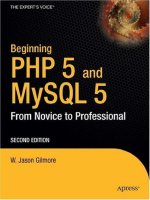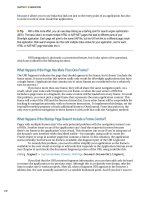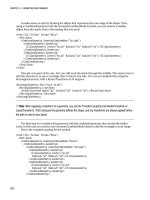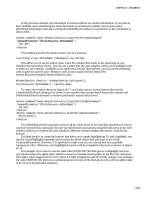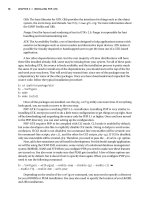apress pro php and jquery 2010 phần 5 potx
Bạn đang xem bản rút gọn của tài liệu. Xem và tải ngay bản đầy đủ của tài liệu tại đây (12 MB, 40 trang )
CHAPTER 4 ■ BUILD AN EVENTS CALENDAR
145
/*
* Return the markup for output
*/
return $html;
}
}
?>
Modifying the Index File
To see the output of the buildCalendar() method, you’ll need to modify index.php in the public folder to
call the method. Update the file with the code shown in bold:
<?php
/*
* Include necessary files
*/
include_once ' /sys/core/init.inc.php';
/*
* Load the calendar for January
*/
$cal = new Calendar($dbo, "2010-01-01 12:00:00");
/*
* Display the calendar HTML
*/
echo $cal->buildCalendar();
?>
Pull up the file in your browser to see the results so far (see Figure 4-4).
From library of Wow! eBook <www.wowebook.com>
CHAPTER 4 ■ BUILD AN EVENTS CALENDAR
146
Figure 4-4. The heading and weekday abbreviations
Building the Calendar
The next step is to build the actual calendar days. Several steps need to be completed for this to work
out:
1. Create a new unordered list.
2. Set up a loop (with an iteration counter, a calendar date counter, today’s date,
and the month and year stored as variables) that runs as long as the calendar
date counter is less than the number of days in the month.
3. Add a fill class to the days of the week that occur before the first.
4. Add a today class if the current date is contained within the same month and
year and matches the date being generated.
5. Create an opening and closing list item tag for each day.
6. Check if the current calendar box falls within the current month, and add the
date if so.
7. Check if the current calendar box is a Saturday, and close the list and open a
new one if so.
8. Assemble the pieces of the list item and append them to the markup.
CHAPTER 4 ■ BUILD AN EVENTS CALENDAR
147
9. After the loop, run another loop to add filler days until the calendar week is
completed.
10. Close the final unordered list and return the markup.
To start, complete steps 1 and 2 by adding the following bold code to the buildCalendar() method:
public function buildCalendar()
{
/*
* Determine the calendar month and create an array of
* weekday abbreviations to label the calendar columns
*/
$cal_month = date('F Y', strtotime($this->_useDate));
$weekdays = array('Sun', 'Mon', 'Tue',
'Wed', 'Thu', 'Fri', 'Sat');
/*
* Add a header to the calendar markup
*/
$html = "\n\t<h2>$cal_month</h2>";
for ( $d=0, $labels=NULL; $d<7; ++$d )
{
$labels .= "\n\t\t<li>" . $weekdays[$d] . "</li>";
}
$html .= "\n\t<ul class=\"weekdays\">"
. $labels . "\n\t</ul>";
/*
* Create the calendar markup
*/
$html .= "\n\t<ul>"; // Start a new unordered list
for ( $i=1, $c=1, $t=date('j'), $m=date('m'), $y=date('Y');
$c<=$this->_daysInMonth; ++$i )
{
// More steps go here
}
/*
* Return the markup for output
*/
return $html;
}
Next, add the bold code below to complete steps 3–5:
public function buildCalendar()
{
/*
* Determine the calendar month and create an array of
* weekday abbreviations to label the calendar columns
*/
CHAPTER 4 ■ BUILD AN EVENTS CALENDAR
148
$cal_month = date('F Y', strtotime($this->_useDate));
$weekdays = array('Sun', 'Mon', 'Tue',
'Wed', 'Thu', 'Fri', 'Sat');
/*
* Add a header to the calendar markup
*/
$html = "\n\t<h2>$cal_month</h2>";
for ( $d=0, $labels=NULL; $d<7; ++$d )
{
$labels .= "\n\t\t<li>" . $weekdays[$d] . "</li>";
}
$html .= "\n\t<ul class=\"weekdays\">"
. $labels . "\n\t</ul>";
/*
* Create the calendar markup
*/
$html .= "\n\t<ul>"; // Start a new unordered list
for ( $i=1, $c=1, $t=date('j'), $m=date('m'), $y=date('Y');
$c<=$this->_daysInMonth; ++$i )
{
/*
* Apply a "fill" class to the boxes occurring before
* the first of the month
*/
$class = $i<=$this->_startDay ? "fill" : NULL;
/*
* Add a "today" class if the current date matches
* the current date
*/
if ( $c==$t && $m==$this->_m && $y==$this->_y )
{
$class = "today";
}
/*
* Build the opening and closing list item tags
*/
$ls = sprintf("\n\t\t<li class=\"%s\">", $class);
$le = "\n\t\t</li>";
// More steps go here
}
/*
* Return the markup for output
*/
return $html;
}
CHAPTER 4 ■ BUILD AN EVENTS CALENDAR
149
To complete steps 6-10—actually build the dates; check if the week needs to wrap; assemble the
date markup; finish the last week out with filler, and return the markup—add the following bold code:
public function buildCalendar()
{
/*
* Determine the calendar month and create an array of
* weekday abbreviations to label the calendar columns
*/
$cal_month = date('F Y', strtotime($this->_useDate));
$weekdays = array('Sun', 'Mon', 'Tue',
'Wed', 'Thu', 'Fri', 'Sat');
/*
* Add a header to the calendar markup
*/
$html = "\n\t<h2>$cal_month</h2>";
for ( $d=0, $labels=NULL; $d<7; ++$d )
{
$labels .= "\n\t\t<li>" . $weekdays[$d] . "</li>";
}
$html .= "\n\t<ul class=\"weekdays\">"
. $labels . "\n\t</ul>";
/*
* Create the calendar markup
*/
$html .= "\n\t<ul>"; // Start a new unordered list
for ( $i=1, $c=1, $t=date('j'), $m=date('m'), $y=date('Y');
$c<=$this->_daysInMonth; ++$i )
{
/*
* Apply a "fill" class to the boxes occurring before
* the first of the month
*/
$class = $i<=$this->_startDay ? "fill" : NULL;
/*
* Add a "today" class if the current date matches
* the current date
*/
if ( $c+1==$t && $m==$this->_m && $y==$this->_y )
{
$class = "today";
}
/*
* Build the opening and closing list item tags
*/
$ls = sprintf("\n\t\t<li class=\"%s\">", $class);
CHAPTER 4 ■ BUILD AN EVENTS CALENDAR
150
$le = "\n\t\t</li>";
/*
* Add the day of the month to identify the calendar box
*/
if ( $this->_startDay<$i && $this->_daysInMonth>=$c)
{
$date = sprintf("\n\t\t\t<strong>%02d</strong>",$c++);
}
else { $date=" "; }
/*
* If the current day is a Saturday, wrap to the next row
*/
$wrap = $i!=0 && $i%7==0 ? "\n\t</ul>\n\t<ul>" : NULL;
/*
* Assemble the pieces into a finished item
*/
$html .= $ls . $date . $le . $wrap;
}
/*
* Add filler to finish out the last week
*/
while ( $i%7!=1 )
{
$html .= "\n\t\t<li class=\"fill\"> </li>";
++$i;
}
/*
* Close the final unordered list
*/
$html .= "\n\t</ul>\n\n";
/*
* Return the markup for output
*/
return $html;
}
Test the function as it stands now, and you’ll see the unordered lists in your browser (see
Figure 4-5).
CHAPTER 4 ■ BUILD AN EVENTS CALENDAR
151
Figure 4-5. The markup as generated by buildCalendar()
Displaying Events in the Calendar
Adding the events to the calendar display is as easy as loading the events array from _createEventObj()
and looping through the events stored in the index that matches the current day if any exist. Add event
data to the calendar markup using the following bold code:
public function buildCalendar()
{
/*
* Determine the calendar month and create an array of
* weekday abbreviations to label the calendar columns
*/
$cal_month = date('F Y', strtotime($this->_useDate));
$weekdays = array('Sun', 'Mon', 'Tue',
'Wed', 'Thu', 'Fri', 'Sat');
/*
* Add a header to the calendar markup
CHAPTER 4 ■ BUILD AN EVENTS CALENDAR
152
*/
$html = "\n\t<h2>$cal_month</h2>";
for ( $d=0, $labels=NULL; $d<7; ++$d )
{
$labels .= "\n\t\t<li>" . $weekdays[$d] . "</li>";
}
$html .= "\n\t<ul class=\"weekdays\">"
. $labels . "\n\t</ul>";
/*
* Load events data
*/
$events = $this->_createEventObj();
/*
* Create the calendar markup
*/
$html .= "\n\t<ul>"; // Start a new unordered list
for ( $i=1, $c=1, $t=date('j'), $m=date('m'), $y=date('Y');
$c<=$this->_daysInMonth; ++$i )
{
/*
* Apply a "fill" class to the boxes occurring before
* the first of the month
*/
$class = $i<=$this->_startDay ? "fill" : NULL;
/*
* Add a "today" class if the current date matches
* the current date
*/
if ( $c+1==$t && $m==$this->_m && $y==$this->_y )
{
$class = "today";
}
/*
* Build the opening and closing list item tags
*/
$ls = sprintf("\n\t\t<li class=\"%s\">", $class);
$le = "\n\t\t</li>";
/*
* Add the day of the month to identify the calendar box
*/
if ( $this->_startDay<$i && $this->_daysInMonth>=$c)
{
/*
* Format events data
*/
$event_info = NULL; // clear the variable
CHAPTER 4 ■ BUILD AN EVENTS CALENDAR
153
if ( isset($events[$c]) )
{
foreach ( $events[$c] as $event )
{
$link = '<a href="view.php?event_id='
. $event->id . '">' . $event->title
. '</a>';
$event_info .= "\n\t\t\t$link";
}
}
$date = sprintf("\n\t\t\t<strong>%02d</strong>",$c++);
}
else { $date=" "; }
/*
* If the current day is a Saturday, wrap to the next row
*/
$wrap = $i!=0 && $i%7==0 ? "\n\t</ul>\n\t<ul>" : NULL;
/*
* Assemble the pieces into a finished item
*/
$html .= $ls . $date . $event_info . $le . $wrap;
}
/*
* Add filler to finish out the last week
*/
while ( $i%7!=1 )
{
$html .= "\n\t\t<li class=\"fill\"> </li>";
++$i;
}
/*
* Close the final unordered list
*/
$html .= "\n\t</ul>\n\n";
/*
* Return the markup for output
*/
return $html;
}
■ Caution Don’t forget to add the new $event_info variable into the markup at the bottom of the loop!
CHAPTER 4 ■ BUILD AN EVENTS CALENDAR
154
When the database events are loaded into the calendar display, the titles show up next to the
appropriate date (see Figure 4-6).
Figure 4-6. An event title displayed next to the appropriate date
■ Note The linked event titles point to a file called view.php that doesn’t exist yet. This file will be built and
explained in the “Outputing HTML to Display Full Event Descriptions” section later in this chapter.
Making the Calendar Look Like a Calendar
At this point, your markup is proper and your events are there, but the generated code doesn’t look
much like a calendar at all.
To rectify this, you’ll now be taking a moment to complete the HTML markup and style the page
using CSS.
CHAPTER 4 ■ BUILD AN EVENTS CALENDAR
155
■ Note Because this book is not about CSS, the rules used won’t be explained in detail. For more information on
CSS, check out Beginning CSS Web Development by Simon Collison (Apress, 2006).
In a nutshell, the CSS file will do the following:
• Float each list item to the left.
• Adjust margins and borders to make the dates look like a traditional calendar.
• Add a hover effect so the day over which the mouse is hovering will be highlighted.
• Style event titles.
• Add hover effects for event titles as well.
• Add some CSS3 flair, including rounded corners and drop shadows, for fun.
■ Tip For more information on CSS3, visit o/.
Create a new file called style.css in the css folder (/public/assets/css/style.css) and add the
following rules:
body {
background-color: #789;
font-family: georgia, serif;
font-size: 13px;
}
#content {
display: block;
width: 812px;
margin: 40px auto 10px;
padding: 10px;
background-color: #FFF;
-moz-border-radius: 6px;
-webkit-border-radius: 6px;
border-radius: 6px;
border:2px solid black;
-moz-box-shadow: 0 0 14px #123;
-webkit-box-shadow: 0 0 14px #123;
box-shadow: 0 0 14px #123;
}
h2,p {
margin: 0 auto 14px;
CHAPTER 4 ■ BUILD AN EVENTS CALENDAR
156
text-align: center;
}
ul {
display: block;
clear: left;
height: 82px;
width: 812px;
margin: 0 auto;
padding: 0;
list-style: none;
background-color: #FFF;
text-align: center;
border: 1px solid black;
border-top: 0;
border-bottom: 2px solid black;
}
li {
position: relative;
float: left;
margin: 0;
padding: 20px 2px 2px;
border-left: 1px solid black;
border-right: 1px solid black;
width: 110px;
height: 60px;
overflow: hidden;
background-color: white;
}
li:hover {
background-color: #FCB;
z-index: 1;
-moz-box-shadow: 0 0 10px #789;
-webkit-box-shadow: 0 0 10px #789;
box-shadow: 0 0 10px #789;
}
.weekdays {
height: 20px;
border-top: 2px solid black;
}
.weekdays li {
height: 16px;
padding: 2px 2px;
background-color: #BCF;
}
.fill {
CHAPTER 4 ■ BUILD AN EVENTS CALENDAR
157
background-color: #BCD;
}
.weekdays li:hover,li.fill:hover {
background-color: #BCD;
-moz-box-shadow: none;
-webkit-box-shadow: none;
box-shadow: none;
}
.weekdays li:hover,.today {
background-color: #BCF;
}
li strong {
position: absolute;
top: 2px;
right: 2px;
}
li a {
position: relative;
display: block;
border: 1px dotted black;
margin: 2px;
padding: 2px;
font-size: 11px;
background-color: #DEF;
text-align: left;
-moz-border-radius: 6px;
-webkit-border-radius: 6px;
border-radius: 6px;
z-index: 1;
text-decoration: none;
color: black;
font-weight: bold;
font-style: italic;
}
li a:hover {
background-color: #BCF;
z-index: 2;
-moz-box-shadow: 0 0 6px #789;
-webkit-box-shadow: 0 0 6px #789;
box-shadow: 0 0 6px #789;
}
Save the style sheet, and close it; you won’t need to modify it again in this chapter. In the next
section, you’ll create common files that will, among other things, include these styles into the page.
CHAPTER 4 ■ BUILD AN EVENTS CALENDAR
158
Creating the Common Files—Header and Footer
There are going to be multiple pages viewed by your users in this application, and they all need a
common set of HTML elements, style sheets, and more. To simplify maintenance as much as possible,
you’ll be using two files—header.inc.php and footer.inc.php—to contain those common elements.
First, create a file called header.inc.php in the common folder
(/public/assets/common/header.inc.php). This file will hold the DOCTYPE declaration for the HTML and
create a head section that contains a Content-Type meta tag, the document title, and links to any CSS files
required for the document.
Because the document title will vary from page to page, you’ll be setting a variable—$page_title—
to store each page’s title.
Also, because more than one CSS file may be needed for a page, an array of CSS file names will be
passed in a variable called $css_files and looped through to generate the proper markup.
Inside this file, place the following code:
<!DOCTYPE html
PUBLIC "-//W3C//DTD XHTML 1.0 Strict//EN"
"
<html xmlns=" xml:lang="en" lang="en">
<head>
<meta http-equiv="Content-Type"
content="text/html;charset=utf-8" />
<title><?php echo $page_title; ?></title>
<?php foreach ( $css_files as $css ): ?>
<link rel="stylesheet" type="text/css" media="screen,projection"
href="assets/css/<?php echo $css; ?>" />
<?php endforeach; ?>
</head>
<body>
Next, create a file called footer.inc.php in the common folder
(/public/assets/common/footer.inc.php) to contain the closing parts of the markup.
For now, this file doesn’t need to do much: it simply closes the body and html tags opened in
header.inc.php. As you continue developing this application, more will be added here.
Insert the following into footer.inc.php:
</body>
</html>
Adding the Files to the Index
To bring the new pieces together, you’ll need to modify the index file. First, you’ll need to add values to
the $page_title and $css_files variables, and then you should include the header file.
Also, to wrap the page content, add in a new div with the ID content that wraps around the call to
buildCalendar().
CHAPTER 4 ■ BUILD AN EVENTS CALENDAR
159
Finally, add a call to the footer file to finish the page. When it’s completed, the index file will be
modified with the code shown in bold:
<?php
/*
* Include necessary files
*/
include_once ' /sys/core/init.inc.php';
/*
* Load the calendar
*/
$cal = new Calendar($dbo, "2010-01-01 12:00:00");
/*
* Set up the page title and CSS files
*/
$page_title = "Events Calendar";
$css_files = array('style.css');
/*
* Include the header
*/
include_once 'assets/common/header.inc.php';
?>
<div id="content">
<?php
/*
* Display the calendar HTML
*/
echo $cal->buildCalendar();
?>
</div><! end #content >
<?php
/*
* Include the footer
*/
include_once 'assets/common/footer.inc.php';
?>
After saving the changes, reload your browser to see the results (see Figure 4-7).
CHAPTER 4 ■ BUILD AN EVENTS CALENDAR
160
Figure 4-7. The calendar with the header, footer, and CSS styles applied
Outputing HTML to Display Full Event Descriptions
The next step in this application is to allow the user to view the details of an event. This will be done in
three steps:
1. Create a method to format an array of a single event’s data when loaded by ID.
2. Create a method to generate markup containing the data as loaded by the first
method.
3. Create a new file to display the markup generated by the second method.
Creating a Method to Format Single Event Data
Similar to _createEventObj(), the purpose of this method, which you’ll call _loadEventById(), is to
generate an Event object from the result set returned by _loadEventData().
CHAPTER 4 ■ BUILD AN EVENTS CALENDAR
161
Because the markup generation is fairly simple when only using one event, all this method will do is
load the desired event by its ID using _loadEventData() and then return the first—and only, due to the
LIMIT 1 clause—result from the method.
Add the following method to the Calendar class:
<?php
class Calendar extends DB_Connect
{
private $_useDate;
private $_m;
private $_y;
private $_daysInMonth;
private $_startDay;
public function __construct($dbo=NULL, $useDate=NULL) { }
public function buildCalendar() { }
private function _loadEventData($id=NULL) { }
private function _createEventObj() { }
/**
* Returns a single event object
*
* @param int $id an event ID
* @return object the event object
*/
private function _loadEventById($id)
{
/*
* If no ID is passed, return NULL
*/
if ( empty($id) )
{
return NULL;
}
/*
* Load the events info array
*/
$event = $this->_loadEventData($id);
/*
* Return an event object
CHAPTER 4 ■ BUILD AN EVENTS CALENDAR
162
*/
if ( isset($event[0]) )
{
return new Event($event[0]);
}
else
{
return NULL;
}
}
}
?>
When called, this method will return an object (for the ID of 1) that looks like this:
Event Object
(
[id] => 1
[title] => New Year's Day
[description] => Happy New Year!
[start] => 2010-01-01 00:00:00
[end] => 2010-01-01 23:59:59
)
Creating a Method to Generate Markup
Now that an array of a single event’s data is available, you can build a new public method to format the
event data into HTML markup.
This method will be called displayEvent(); it will accept an event’s ID and generate HTML markup
using the following steps:
1. Load the event data using _loadEventById().
2. Use the start and end dates to generate strings to describe the event.
3. Return the HTML markup to display the event.
Create the displayEvent() method by adding the bold code to the Calendar class:
<?php
class Calendar extends DB_Connect
{
private $_useDate;
private $_m;
private $_y;
CHAPTER 4 ■ BUILD AN EVENTS CALENDAR
163
private $_daysInMonth;
private $_startDay;
public function __construct($dbo=NULL, $useDate=NULL) { }
public function buildCalendar() { }
/**
* Displays a given event's information
*
* @param int $id the event ID
* @return string basic markup to display the event info
*/
public function displayEvent($id)
{
/*
* Make sure an ID was passed
*/
if ( empty($id) ) { return NULL; }
/*
* Make sure the ID is an integer
*/
$id = preg_replace('/[^0-9]/', '', $id);
/*
* Load the event data from the DB
*/
$event = $this->_loadEventById($id);
/*
* Generate strings for the date, start, and end time
*/
$ts = strtotime($event->start);
$date = date('F d, Y', $ts);
$start = date('g:ia', $ts);
$end = date('g:ia', strtotime($event->end));
/*
* Generate and return the markup
*/
return "<h2>$event->title</h2>"
. "\n\t<p class=\"dates\">$date, $start—$end</p>"
. "\n\t<p>$event->description</p>";
}
private function _loadEventData($id=NULL) { }
CHAPTER 4 ■ BUILD AN EVENTS CALENDAR
164
private function _createEventObj() { }
private function _loadEventById($id) { }
}
?>
Creating a New File to Display Full Events
To display the output of displayEvent(), you’ll create a new file. This file will be called view.php, and it
will reside in the public folder (/public/view.php).
This file will be called with a query string containing the ID of the event to be displayed. If no ID is
supplied, the user will be sent back out to the main view of the calendar.
At the top of view.php, check for an event ID, and then load the initialization file; the page title and
CSS file are set up in variables, and the header file is called. After that, a new instance of the Calendar
class is created.
Next, set up a new div with the ID of content and call the displayEvent() method. Add a link to go
back to the main calendar page, close the div, and include the footer.
All things considered, the file should end up looking like this:
<?php
/*
* Make sure the event ID was passed
*/
if ( isset($_GET['event_id']) )
{
/*
* Make sure the ID is an integer
*/
$id = preg_replace('/[^0-9]/', '', $_GET['event_id']);
/*
* If the ID isn't valid, send the user to the main page
*/
if ( empty($id) )
{
header("Location: ./");
exit;
}
}
else
{
/*
* Send the user to the main page if no ID is supplied
*/
header("Location: ./");
exit;
}
CHAPTER 4 ■ BUILD AN EVENTS CALENDAR
165
/*
* Include necessary files
*/
include_once ' /sys/core/init.inc.php';
/*
* Output the header
*/
$page_title = "View Event";
$css_files = array("style.css");
include_once 'assets/common/header.inc.php';
/*
* Load the calendar
*/
$cal = new Calendar($dbo);
?>
<div id="content">
<?php echo $cal->displayEvent($id) ?>
<a href="./">« Back to the calendar</a>
</div><! end #content >
<?php
/*
* Output the footer
*/
include_once 'assets/common/footer.inc.php';
?>
Test this file by going back to the main calendar and clicking an event title. The view.php file loads
and displays the event information in a format that matches the calendar (see Figure 4-8).
CHAPTER 4 ■ BUILD AN EVENTS CALENDAR
166
Figure 4-8. The event information displayed after clicking an event title
Summary
You now have a fully functional events calendar, which you created using object-oriented PHP and
MySQL. Along the way, you learned how to handle dates, how to organize entries into objects for easy
access, and how to output markup and stylesheets to resemble a traditional calendar. In the next
chapter, you’ll build controls to add, edit, and create events.
C H A P T E R 5
■ ■ ■
167
Add Controls to Create, Edit,
and Delete Events
Now that the calendar can be viewed, you need to add controls that will allow administrators to create,
edit, and delete events.
Generating a Form to Create or Edit Events
To edit an event or add new events to the calendar, you need to use a form. You do this by adding a
method called displayForm() that generates a form for editing and creating events to the Calendar class.
This simple method accomplishes the following tasks:
1. Checks for an integer passed as the event ID.
2. Instantiates empty variables for the different fields used to describe events.
3. Loads event data if an event ID was passed.
4. Stores event data in the variables instantiated earlier if it exists.
5. Outputs a form.
■ Note By explicitly sanitizing the event ID passed in the $_POST superglobal, you ensure that the ID is safe to use
since any non-integer values will be converted to 0.
You build the displayForm() method by adding the following bold code to the Calendar class:
<?php
class Calendar extends DB_Connect
{
private $_useDate;
private $_m;
CHAPTER 5 ■ ADD CONTROLS TO CREATE, EDIT, AND DELETE EVENTS
168
private $_y;
private $_daysInMonth;
private $_startDay;
public function __construct($dbo=NULL, $useDate=NULL) { }
public function buildCalendar() { }
public function displayEvent($id) { }
/**
* Generates a form to edit or create events
*
* @return string the HTML markup for the editing form
*/
public function displayForm()
{
/*
* Check if an ID was passed
*/
if ( isset($_POST['event_id']) )
{
$id = (int) $_POST['event_id'];
// Force integer type to sanitize data
}
else
{
$id = NULL;
}
/*
* Instantiate the headline/submit button text
*/
$submit = "Create a New Event";
/*
* If an ID is passed, loads the associated event
*/
if ( !empty($id) )
{
$event = $this->_loadEventById($id);
/*
* If no object is returned, return NULL
*/
if ( !is_object($event) ) { return NULL; }
$submit = "Edit This Event";
CHAPTER 5 ■ ADD CONTROLS TO CREATE, EDIT, AND DELETE EVENTS
169
}
/*
* Build the markup
*/
return <<<FORM_MARKUP
<form action="assets/inc/process.inc.php" method="post">
<fieldset>
<legend>$submit</legend>
<label for="event_title">Event Title</label>
<input type="text" name="event_title"
id="event_title" value="$event->title" />
<label for="event_start">Start Time</label>
<input type="text" name="event_start"
id="event_start" value="$event->start" />
<label for="event_end">End Time</label>
<input type="text" name="event_end"
id="event_end" value="$event->end" />
<label for="event_description">Event Description</label>
<textarea name="event_description"
id="event_description">$event->description</textarea>
<input type="hidden" name="event_id" value="$event->id" />
<input type="hidden" name="token" value="$_SESSION[token]" />
<input type="hidden" name="action" value="event_edit" />
<input type="submit" name="event_submit" value="$submit" />
or <a href="./">cancel</a>
</fieldset>
</form>
FORM_MARKUP;
}
private function _loadEventData($id=NULL) { }
private function _createEventObj() { }
private function _loadEventById($id) { }
}
?>
Adding a Token to the Form
If you look at the preceding form, there’s a hidden input named token that holds a session value, also
called token. This is a security measure to prevent cross-site request forgeries (CSRF), which are form
submissions that are faked by submitting a form to your app’s processing file from somewhere other
than the form itself. This is a common tactic used by spammers to send multiple forged entry
submissions, which is annoying, potentially harmful, and definitely undesirable.
